
SHORT URL: http://tinyurl.com/Steele-Analysis
I was thinking this morning about how little has changed since I was a founding member of the Advanced Information Processing and Analysis Steering Group (AIPASG) and also a member of the Information Handling Committee (IHC) for the US secret world (late 1980's early 1990's).
I note in passing my continued dismay as I see — year after year — papers that address the problem without doing their homework. In relation to just two of the eight factors below (proessing), I note that one paper, “Top Ten Needs for Intelligence Analysis Tool Development“(Batelle, 2009) did a nice day's work without ever discovering the original four requirements documents (CIA, USMC, 1989). Worse, I am seeing papers today about to be published, that themselves take the 2009 article at face value without having a clue that there is so much more work that has been done….and been ignored by intelligence community seniors. Everyone goes through the motions. NGA means well but it will never accomplish what it claims to be already be doing. Ask them when their cave will be at the White House. At OMB. At CIA or DIA. At a theater command. In Afghanistan. The truthful answer is “not in my lifetime.”
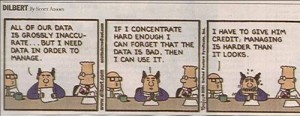
NGA's ideas are very expensive non-inter-operable, bandwidth-impossible, non-scalable day dreams. Saying — as was said today at AFIO — that the NRO is responsible for all the big data hard stuff — the pipes, the speeds, the feeds — is an unprofessional cop-out. Even the idea of reversing the 75-25 ratio between legacy government software and COTS is wrong headed — only open source everything is affordable, interoperable, and scalable. What NGA leadership does not know about nuts and bolts is troubling. If the next USDI goes down this path, our analysts will continue to be the redheaded step kids locked in the closet with a sock in their mouth — and our strategists, policy-makers, acquisition managers, and operational commanders will continue to be (as Mike Flynn was and remains) screwed by a system that cares more about keeping the money moving than it does about serving our troops and those that train, organize, and equip our national capabilities. CrisisMappers, humanitarian UAVs, non-US commercially-created geospatial, and unfettered multinational open sources are all part of the solution — and are all banned from discussion within the US secret world.
When things are not going well, until you get the truth out on the table, no matter how ugly, you are not in a position to deal with it. Bob Seelert, Chairman of Saatchi & Saatchi Worldwide (New York)
Below is my rough take on where the US Intelligence Community stands today on analytic excellence. The green outside the IC borders represents all of the possibilities that are actively and inexpensively present.
I worked with four quadrants, as is my custom.
Quadrant A: Source Diversity and Source Integrity
Quadrant B: Processing Big Data and Processing Desktop
Quadrant C: Analyst Education & Training and Analyst Outreach
Quadrant D: Analyst Access to Deciders and Deciders Integrity
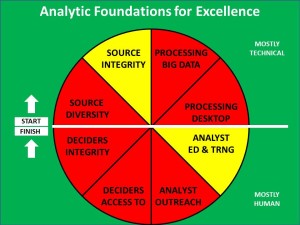
Appraisal
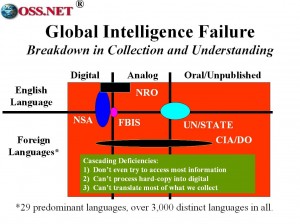
Source Diversity. Virtually nothing has changed — all misrepresentations notwithstanding — since I published my appraisals in the early 1990's in article form and then in book form beginning with ON INTELLIGENCE: Spies & Secrecy in an Open World (AFCEA, 2000). We continue to emphasize secret technical collection to the exclusion of all else. Human Intelligence across all fifteen slices is dead. Indeed, there is not an intelligence manager today who could even name all fifteen slices, much less manage them. Open Source Intelligence is a atravesty — the Open Source Center is forbidden by CIA's clandestine service from actually talking to subject matter experts outside their narrow (and now strictly internal) translation domain. Multinational sharing is dominated by NSA's subsidization of foreign signals intelligence to the detriment of all else.
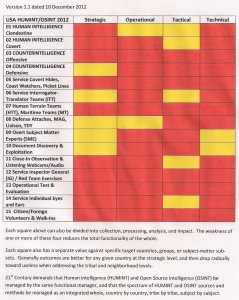
Source Integrity. The technical fidelity of what is collected is quite good in signals and imagery. I don't know enough about Measurements & Signatures other that to consider most of it over-hyped and over-priced. The fidelity of clandestine and overt human intelligene is in the bottom twenty percent. Most “clandestine” reporting is a hand-out from foreign liaison (for example, we constantly get Afghanistan wrong because we are foolish enough to take most of our information from Pakistan), or legal traveler debriefings in the USA. Easily 90% of readily available open sources are not tapped. In relation to Afghanistan, for example, we have refused to be serious about Arabic, Chinese, French, Iranian, Russian, Turkish, and Uzbek sources, to name just a few.
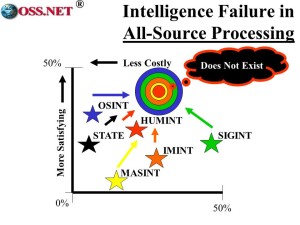
Processing Big Data. Based on the reports I have received from those attending GEOINT, everyone drank the Jonestown Kool-Aid and big data from persistent surveillance is the salvation of the intelligence-industrial complex. All nonsense as I have spelled out in a recent post, Why Big Data is Stillborn (for Now) + Comments from EIN Technical Council. As best I can tell from open sources, NSA still processes less than 1% of what it collects in anything near real time, with 5% being a generous estimate for higher-priority targets. We are still lacking in the ultimate imagery product, 1:50,000 combat charts, something I believe needs an earnest appraisal from within in the very near term, see the 1990 baseline, GEOINT State of the World.
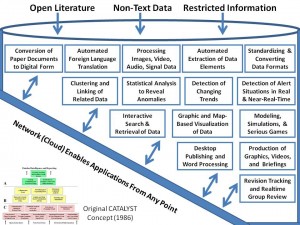
Processing Desktop. I have zero regard for all existing options. In Afghanistan the standard is still M-3 and hand-made powerpoint slides. M-3 can barely handle boolean queries and does not offer clustering and visualization such has N-GRAMS could do in 1986. Computer- Aided Tools for the Analysis of Science & Technology (CATALYST) remains the gold standard. The US IC is not alone in refusing to be serious about desktop analytics — they are joined by Google, IBM, Microsoft, and Oracle. Part of the problem is that geospatial attributes have still not been integrated into all data from all disciplines, something I called for at the 1988 meeting in Tampa of the General Defense Intelligence Program (GRIP), a meeting attended by Keith Hall. Another part of the problem is that analysis is still bogged down in searching for data across 80 databases and 2500 compartments, and in industrial-era production that also forbids contact with real people — especially foreigners with eyes on the target. No one seems to care about empowering analysts, they are a form of serf, a butt in a seat, not a mind to be nurtured. STRONG ANGEL at DARPA, and USSOCOM J-23, got as close as anyone could get, and so of course both have been dismantled.
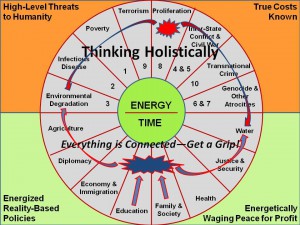
Analyst Education & Training. As I have said often, you cannot have smart spies on top of a dumb nation. Our educational system has hit bottom, and while a few great scholar-thinkers might apply, on balance we are getting a mix of children who could not make it in the private sector, and retreads from the military that could not make it in the private sector. The starting point is low, the follow-on training lower still. We do not teach all threats, all policies, holistic analytics, or true cost economics. There is no point to trying to do analysis if you lack the cultural, historical, and linguistic knowledge necessary to devine the intuitive leaps; if you lack the tools to make sense of multi-lingugal data (when you can get it) and you are fobidden to talk to 95% of the people on the planet with relevant knowledge. [At least as a clandestine case officer I was trusted to talk to anyone anywhere — the same ethic needs to apply to analyts.] I am increasingly of the view both case officers and analysts should be recruited in the 35-55 year age range, rather than the not to exceed 35 years as is now the case. Analysts and case officers are similar to the infantry within the Pentagon — 4% of the force, 80% of the casualties (I count suicide), 1% of the budget. That is just flat out wrong and should be one of the top three corrections made by the next DNI and next USDI.
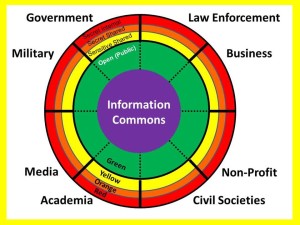
Analyst Outreach. Government is the beneficiary of others people's knowledge, not the benefactor. Over 80% of what we need to know — and more often over 95% — is known by someone that is not a US citizen, does not have clearances, and generally holds the US Government generally and the US Intelligence Community particularly, in high disdain. It does not help to have children or retreads putting on airs because of their jobs, when their knowledge is shallow and their mind narrow. Being an all-source analyst should in the ideal be the top sabatical for deeply steeped experts from the other seven tribes, each with journeymen and apprentice analysts, ideally with a University of the Republic offering analytic training to all eight tribes at the entry, mid-career, and executive service level — one of the things I want the Open Source Agency to fund and nurture. If you cannot find the top dozen people via citation analytics and other means, and TALK TO THEM regardless of their nationality, station in life, or ideological biases, then you are nothing more than a gerbil on a wheel — as Madeline Albright so quaintly described her job as Secretary of State, so you are in good company.
Analyst Access to Deciders. This has not changed in a quarter century, in part because Paul Pillar is absolutely right, the deciders do not really care what the analysts think, half because the analysts have little to offer, the other half because the deciders make their decisions on the basis of ideology and who pays to be heard, not on the basis of ethical evidence-based decision-support, even if the US Intelligence Community knew how to do this — it does not.

Deciders Integrity. I find that I always have to stress that integrity is about holistic coherence, not just personal honor. However well-intentioned deciders may be in developing strategy (we have none), doing acquisition (a monstrous travesty), making policy (pathetically ignorant and dysjointed) or planning operations (Afghanistan is not what winning looks like, Afghanistan is what American idiocy on steroids looks like), the fact is that the White House does not lead, Congress does not authorize and appropriate, and OMB does not manage toward Whole of Government reality-based endeavors in the public interest. The deciders do not want to fix intelligence — intelligence is, as William Binney (among others) has pointed out, focused on keeping the problems alive so the money will keep moving and growing (which has the added advantage of delivering 5% of a larger secret pot to the Congressonal sponsors of intelligence pork). I anticipate no change at all in the balance of this Administration BUT miracles do happen, hope is a good thing.
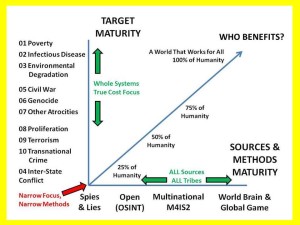
Here to the side is my vision for the future of intelligence. Below, just for grins are some deja vu charts from my first book in 2000, each addresses analysis. I am increasingly of the view that CrisisMappers and other citizen-led endeavors are going to be the pathfinders going forward, and that the US secret world is, as Charles Faddis has labled CIA, “beyond repair.” Google Earth plus a few odds and ends I could put together with a dozen phone calls is capable of burying both the NGA and USGS. I am not giving up — I tried to help Flynn and I will continue to try to help others, but they have to want to get it right, not just play the game for retirement points and post-retirement jobs.
2012 USA Intelligence Scorecard – Deja Vu 2000 1 of 5
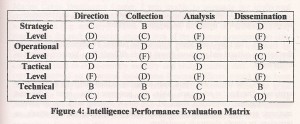
First grade is against the traditional denied area targets. Second grade (in parenthesis) is against the emerging threats identified by the Commandant of the Marine Corps and Robert Steele in 1989-1992.
2012 USA Intelligence Scorecard – Deja Vu 2000 2 of 5
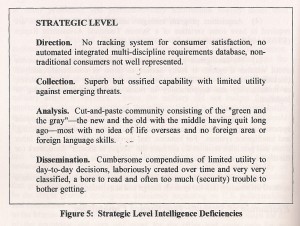
2012 USA Intelligence Scorecard – Deja Vu 2000 3 of 5
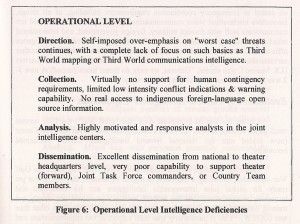
2012 USA Intelligence Scorecard – Deja Vu 2000 4 of 5
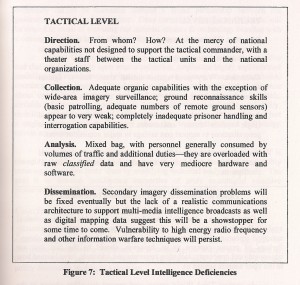
2012 USA Intelligence Scorecard – Deja Vu 2000 5 of 5
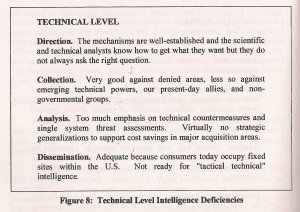
FEEDBACK SOLICITED: My email is robert.david.steele.vivas [at] gmail [dot] com. We had to turn off all comments because there were just too many spammers weaseling their way through trying (but failing) to turn Phi Beta Iota into a malware distributor. I will gladly post substantive comments with or without attribution as desired, and of course engage all who wish to be engaged.
SEEKING WORK: By the by, I am seeking work. Have TS, SCI-eligible but not adjudicated. I have been found eligible and referred for a variety of positions including many DISL positions, but I have been away for to long. Someone has to want me “by name” for me to be fairly considered. Have brain, will travel. I am vastly more loyal than people give me credit for. Resumes approved by CIA/PRB are here.
NEW RELATED POSTS:
Anonymous Feedback on Robert Steele’s Appraisal of Analytic Foundations — Agreement & Extension
See Especially:
Computer-Aided Tools @ Phi Beta Iota
Mini-Me: Palantir's OSINT Demo + Palantir & All-Source Workstation Round-Up
2010 Robert Steele: Reflections on Integrity UPDATED + Integrity RECAP
See Also:
2015 Steele's New Book
2014 Beyond OSA
2014 PhD Proposal
2014 Steele's Open Letter
2014 UN @ Phi Beta Iota
2013 Intelligence Future
2012 Academy Briefing
1989+ Intelligence Reform
1976+ Intelligence Models 2.1
1957+ Decision Support Story



